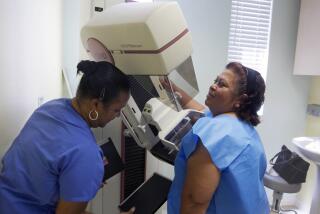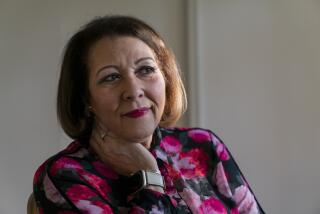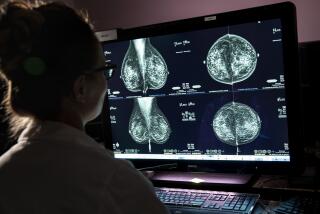Mammograms and Hope
- Share via
For any woman who’s had breast cancer--and for every woman who fears it--listening to the current debate over the scientific value of mammography must seem like watching an atheist try to convince a true believer that God doesn’t exist. It’s engaging but irrelevant.
A National Cancer Institute study released last month underscores the earlier findings of Danish scientists that regular mammograms may not be the lifesaver long believed. For women with aggressive and fast-growing tumors, even catching the cancer early may not change the outcome. And women whose tumors are slow-growing may do fine even if the cancer isn’t detected until it’s large enough to feel.
Perhaps mammography is most helpful, these researchers conclude, for women whose tumors are somewhere between, neither particularly aggressive nor slow-growing. These tumors represent just 15% to 20% of all breast cancers. The researchers argue that routine screenings don’t make sense for most women.
Other scientists dispute these conclusions, claiming that the studies are methodologically flawed. They say mammograms save more lives than skeptics grasp, and they urge women to continue to be screened. Is it any wonder that most women will align themselves with this camp? Is there any rational reason not to?
Yes. Cost. Mammograms average $100, although many clinics charge much less. Overall, the national tab for breast cancer screening runs into many millions each year. If managed care agencies cut out most annual exams, the potential cost savings for insurers--and the individuals and corporations who pay their premiums--would be significant. In other words, if mammography’s critics are right, a decision grounded in a cost-benefit analysis based on statistics may make economic sense.
But ask an individual woman if $100 is too high an annual price to put on the measure of peace of mind such tests can bring. The managed care industry might ask that too, in weighing whether to dump testing. The issue, after all, is survival.
More than 30 years after President Nixon declared a “war on cancer,” the disease still bedevils physicians and terrifies its victims. An estimated 205,000 women will be found to have breast cancer this year and 40,000 will die of the disease. After all the celebrity run/walks, the lobbying and the billions spent on research, there’s still no cure in sight. The death rate has dropped slightly over the last decade, but for too many the discovery of a tumor is still the beginning of a long and ghastly end. In the absence of a “magic” cure, women have come to believe that mammograms are a key to their survival.
Women don’t need the National Cancer Institute to convince them that mammograms are far from foolproof. At the same time, no one doubts that they do work. Sometimes. With cancer, there is never a certain death, never a sure cure. And until that cure is discovered, a woman is left with a faith that flows in part from the knowledge--or is it now chimera?--that there is something she can do to reduce the odds that a lump that can’t be felt will quickly cause havoc throughout her body. Medical exams are never pleasant, and no woman looks forward to having her breasts squeezed between those cold glass plates. But it certainly beats simply crossing her fingers.






